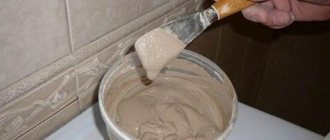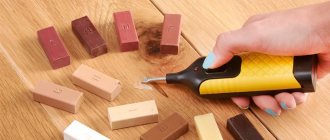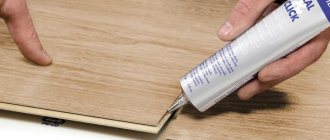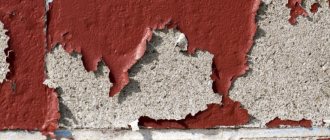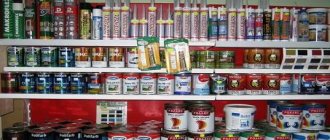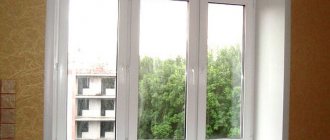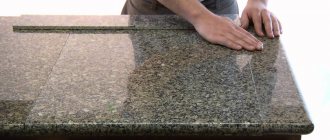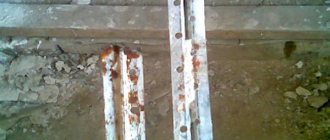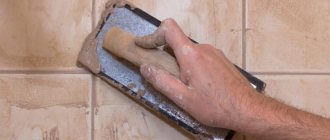Special mastic
It is used on undamaged laminate flooring to protect it from future damage.
Mastic is sold both as a spray and as an emulsion. There are no difficulties with use - the material is simply rubbed into the surface (for example, using a sponge). Although the emulsion is more difficult to apply, it provides better protection for the slats. It is better to apply the product with a sponge
Note! When applying mastic, make sure that no unattractive stains remain on the surface. As a rule, they appear due to poor rubbing of the composition (this must be done along the fibers of the laminate)
The mastic must be applied carefully
A water-based emulsion, by the way, is somewhat easier to rub in. Simply dilute it with water according to the instructions and apply to the floor covering. In other words, you will wash the floor with the prepared mixture and let it dry.
Important information! Interestingly, mastic is not only glossy, but also matte. Regardless of the type, mastic protects equally effectively. Here you just need to decide what the resulting gender should be.
Master Class. How to use mastic
Step 1. First, purchase mastic and carefully read the manufacturer's instructions. Then proceed to prepare the floor - sweep it, remove debris, wash it thoroughly and wait until it is completely dry.
Floor preparation
Step 2. Next, arm yourself with a sponge (you can take a small rag with a little lint) and mastic itself. Apply a little mixture to a rag to gradually treat the laminate.
Preparation for applying mastic
Step 3. Gently rub the mastic in, moving in the direction of the pattern. Make sure that there are no untreated areas or places where the composition has been applied poorly. Do everything in stages, that is, start from the far corner of the room and gradually move towards the exit.
Rubbing in mastic
Step 4. After finishing the treatment, wait for the mastic to dry and remove any excess by wiping the floor. It would seem that everything is extremely simple, but in reality it is painstaking work that requires a lot of time and effort.
The floor is wiped after the mastic has dried
Note! After completing the treatment, try not to walk on the coating for at least a few more hours.
Rubbing laminate flooring with mastic
Often, mastic compounds are used to rub laminate flooring to restore the same shine and shade of old laminated panels. This is a fairly common practice that is recommended by many experts. Using this technology, it is possible to provide laminated panels with a good protective effect, as well as to perfectly mask minor flaws and defects on the floor surface. The only drawback of this type of processing is the difficulty of carrying out the work if there is no experience in such processes. It will be especially difficult if you need to process a fairly large area.
The mastic composition must be applied to a fine-pile cloth and very carefully and calmly distributed over the surface of the laminate. In theory, everything seems quite simple, but you need to prepare for long and painstaking work. The ideal option is to view thematic materials on the Internet before starting work.
In addition, before treating laminated boards with mastic compounds, it is necessary to wash the floors and allow them to dry. Also, do not walk on the flooring until the mastic composition is completely dry after treatment.
Advantages of using impregnation to protect against water
How to make varnished laminate flooring with your own hands
Protecting laminate flooring from moisture is the main requirement in the kitchen. The main advantages of using impregnation include increasing the service life of the floor covering. In the most vulnerable places it is necessary to apply a special impregnation. It is necessary to carefully process all joints and locking joints. This will provide good protection against moisture penetration, and will save owners from constantly repairing the floor or partially replacing it in areas of damage. A properly chosen moisture protection agent at the joints will be a reliable barrier against water getting into them.
Laminate must be protected from moisture
How to fix defects
Removal of swollen lamellas can be carried out without disassembling the row to achieve positive results. If the swelling occurs in a small area, you need to dismantle the floor covering and replace the damaged slats with new ones.
If the panels are swollen due to temperature changes, this problem is resolved as follows.
- We remove the baseboards.
- We take out the outer slats.
- We cut the edge with a hacksaw.
- We carefully place the cut lamellas in their original place.
- We install skirting boards.
After a few days, the “behaved” material should return.
The problem of bloating can be corrected in several ways. It depends on the reasons for their occurrence
If the material is swollen from moisture, you must:
- remove furniture from the room;
- open the windows and let the panels dry;
- You can try drying them with a hairdryer. It takes 3-5 days to dry the laminate.
If it was not possible to eliminate the defects in this way.
- Remove the damaged area. In this case, number the boards on the wrong side.
- Remove moisture from the base and leave the floors disassembled for 5 days.
- Remove any mold or damage that appears. Treat the lock joints with wax or oil.
- Place the slats in place according to their numbering.
- If the slats are completely damaged, replace them with new ones.
To avoid such problems, purchase high-quality and proven material. To do this, you will have to study its technical characteristics and reviews from previous customers. Be sure to lay the material only on a carefully prepared base with thick plastic film. Do not forget to leave gaps between the walls and slats of at least 1.2-2 cm. Treat all joints and interlocking joints with impregnations or water-repellent compounds.
To avoid such problems, you need to choose quality material
What is mastic used for?
Laying film under laminate
Laminate, despite its availability and practicality, has some disadvantages. For example, he does not “like” people walking on him in thin heels or dropping sharp objects on him, and does not tolerate high humidity in the room. Of course, there are types of laminate with increased strength and moisture resistance, but they, as a rule, cost much more than usual. For this reason, a simple laminate is usually used, which is not exposed to many negative factors.
Laminate layers
At the same time, you can protect even the cheapest laminate. Often wax or special mastic is used for these purposes. And to protect the joints from moisture, a special sealant is used.
Why do you need mastic for laminate flooring?
On a note! If you use a cheap laminate, you must first of all take care of protecting the joints, and immediately over the entire floor area. Due to the fact that the material is most susceptible to moisture, which tends to penetrate inside the boards through unprotected locks.
Table. About the use of laminate of different classes.
| Material class | Load | Where is it used? | Operational life, years |
| 21 | Low | Living rooms (living room, study) | 1-2 |
| 22 | Average | Living rooms (living room, children's room) | From 2 to 4 |
| 23 | High | Living rooms (kitchen, corridor) | From 4 to 6 |
| 31 | Low | Public rooms (for example, for negotiations) | From 10 to 12 |
| 32 | Average | Reception areas, office spaces | From 12 to 15 |
| 33 | High | Premises with high traffic (cafes, shops) | From 15 to 20 |
Special synthetic substances are used to make mastic, thanks to which it protects the lamellas from damage and increases their wear resistance. But note that mastic can be used to cover not only the surface of the material, but also the joints between the lamellas, so that moisture will not penetrate inside.
Mastic prevents moisture from entering the lamella
On a note! The first use of mastic should occur immediately after laying the floor covering. Therefore, it is recommended to buy it together with the laminate itself.
Mastic for laminate, parquet boards, parquet VALO
Laying and processing boards
What is necessary in order to do a high-quality installation of flooring? This:
- safety glasses and gloves;
- respirator;
- spatula made of rubber;
- sponge;
- soft rags.
After the material is selected and laid, it awaits processing. Lock connections especially need this. Although laminate is wear-resistant, in places where there are high loads, a material with a high strength class should be used. But laminate joints are more vulnerable. For this reason, they must be handled with care during assembly.
If the seams are treated in a timely manner with special wax, you can achieve protection from various influences, as well as the seepage of liquid when it hits the surface of the laminate.
How to Clean Laminate Floors
How to clean laminate floors
Is it possible to put laminate on linoleum?
Shaw laminate flooring is naturally durable and easy to clean. Here we'll give you a crash course on how to care for your laminate flooring and keep it looking great for years to come. The main thing you have to remember is that moisture and wood don't mix—period. Since our laminate flooring is made of wood, it is important to avoid exposure to moisture.
Cleaning laminate floors:
Do not use steam cleaners or wet mops as they can cause permanent damage to your floor. Use a damp cloth to blot up spills as soon as they occur. Never allow liquids to sit on the floor. To remove tough stains such as oil, paint, markers, lipstick, mascara or tar, use acetone/nail polish remover on a clean white cloth. Then wipe the area with a damp cloth to remove any residue. Regularly sweep, dust, or vacuum your floor using a hard floor attachment (not a beater) to prevent dirt and grit from accumulating, which can scratch or dull the floor surface. Periodically clean the floor with cleaning products specifically designed for laminate flooring. Do not wash or wet mop the floor with soap, water, oil soap detergent, or other liquid cleaners. This may cause bulging, warping, delamination and seam line separation, and may void your warranty. Avoid using steel wool, abrasive cleaners, or strong ammoniated or chlorinated cleaners. Do not use any buffing or buffing machines to clean laminate floors.
For stains such as candle wax or chewing gum, ice the stain and then gently scrape with a plastic scraper such as a credit card. Be careful not to scratch the floor surface
Wipe with a damp cloth. More frequent dusting or vacuuming may be required in very sandy areas such as a beachfront home.
As appealing as it may seem, avoid using homemade cleaning products made from products around the house and remember: never get your mop wet! As we mentioned in the first point, never, ever use a steam mop. Steam mops use heated water to force steam onto the floor surface. The joints between laminate planks connect well and we work to make sure they connect very well, but they are not waterproof. Steam can penetrate joints, and steam is water. The steam from a steam mop can cause damage to the floor in the form of peeling, blistering and swelling. The floor warranty does not cover damage caused by such cleaning systems.
Keep your laminate floor looking new.
- Entry mats catch dirt, grit, grit and other substances such as oil, asphalt or driveway sealant that might otherwise remain on your floor.
- To prevent rugs from slipping, use an approved vinyl rug backing.
- Use floor protectors and wide load bearing foot supports/rollers to minimize the likelihood of dents and scratches from heavy objects. Generally, the heavier the object, the wider the floor protector.
- Maintain a normal indoor relative humidity level of 35% to 65% throughout the year to minimize the natural expansion and contraction of wood.
- Heating season (dry): It is recommended to use a humidifier to prevent excessive shrinkage due to low humidity levels. The wood stove and electric heat create very dry conditions.
- Unheated Season (Wet): An air conditioner, dehumidifier, or turning on the heat periodically will help maintain humidity during the summer months.
- Avoid excessive exposure to water during inclement weather.
- Keep pets' nails trimmed to prevent them from scratching the floor.
- Never try to slide heavy objects across the floor.
- Use a protective mat for furniture or chairs on wheels.
Laminate floor repair
Waxing joints
Laminate flooring installation diagram.
As you know, one of the most sensitive areas of laminate flooring is the locking structures. They lack a protective base, so they can be easily damaged due to regular exposure to dampness coming from the outside and from the floors themselves. As a result of waxing, joints acquire a protective film, so they are not afraid of moisture. This pencil should only be used at locking joints. As a result of such influences, the following can be achieved, i.e. This processing also solves other problems:
- strengthens the strength of locks, making them unchangeable due to exposure to heavy objects;
- helps to lay laminate flooring simply and effortlessly;
- does not allow the base of the floor to creak.
Nowadays you can buy laminate flooring with waxed locks, but their prices will vary significantly. On the one hand, such a purchase will be profitable, because you will not need to spend time on processing the seams, on the other hand, such a material should be chosen very carefully, since small defects and manufacturing defects may be hidden under the wax impregnation.
Thanks to wax sticks, you can protect your laminate floor from various influences, such as moisture, heat or shock.
To save a lot of money, you can buy a sealant that consists of wax. Before installation, treat the locks with this composition. There should be no problems with purchasing sealant, because most manufacturers are simultaneously producing laminate care products.
Article on the topic: Circular shower - to improve immunity and beauty of the skin!
Scratches that occur during the installation process can be treated with a wax pencil, which is sold in hardware stores. This product will help restore laminate flooring and eliminate chipped surfaces.
In case of severe damage to the laminate surface, the wax must be applied in a thick layer in several layers, each of which must dry, and then they must be polished. Before applying such a wax-based pencil to the surface, it is necessary to melt it, then lubricate the hole and dry it. Before starting treatment, you need to apply a degreasing compound to the floor and clean it well. The right color of wax pencil will make the scratch invisible.
After installation, the laminate can be treated with a special mastic and emulsion that contains wax, paraffin, and polyurethane. These products create protection, a kind of barrier on the floor surface. Then the laminate will not be afraid of dampness, dust accumulation on its surface and between the seams.
Scheme for sealing cracks and sanding a wooden floor.
After laying the laminate, you need to thoroughly clean its surface; you can use a vacuum cleaner. Everything, even the smallest specks, must be removed. Do not allow dust to get into the space between the panels.
Let us note this peculiarity: all materials made on a wax basis should be used only for processing locks, since wax applied to the laminate leaves streaks and unsightly marks.
The mastic is applied with a rubber spatula to the connection points of the laminate panels. Excess product should be removed, then polish the treated surface.
Throughout the entire work, care should be taken to ensure the safety of the respiratory system: this product will actively evaporate during such manipulations. You should wear a respirator. Once the surface has dried (approximately 4 hours), it is recommended to clean the entire floor surface.
Laminate polish
To give the flooring smoothness and a special gloss, after installation it is rubbed with a special polish. These products can be produced in various forms, both in the form of a liquid spray and solid mastic. There is no need to be very zealous and rub it into the floor.
Areas with significant damage deserve special attention. For a smoother and more uniform application, use a sponge or soft cloth
The mastic should be applied along the lines of the laminate board. This will avoid unnecessary streaks and stains.
For a smoother and more uniform application, use a sponge or soft cloth. The mastic should be applied along the lines of the laminate board. This will avoid unnecessary streaks and stains.
This process takes a lot of time and effort. However, the result will exceed your expectations.
Based on whether the laminate is glossy or matte, the processing agents are selected. If you make the wrong choice, all your hard work will be in vain and the floor will look ugly.
Additional information: How to treat the edges of laminate flooring for greater moisture resistance
If cracks or scratches occur while laying the board, treat the damaged areas with a wax pencil. How to treat a wooden fence post for the part that will be in the ground? It will easily restore the laminate and smooth out all the chips that have formed on the surface.
If the surface is significantly damaged, then apply a thick layer of wax several times, after waiting until the previous one has dried. Before use, the pencil must be melted, then lubricated on the damaged area and dried thoroughly. The main thing is to choose the right shade of pencil, then the flaws will be completely invisible.
To increase the moisture resistance of the laminate, the ends of the plates should be treated with waterproof impregnation before installation. We are not talking about some special preparation, but about ordinary impregnation for shoes. This type of treatment is suitable for inexpensive laminates belonging to class 31.
It makes sense to use it in those rooms where water is most likely to enter: corridors and hallways, balconies and kitchens.
You can also use regular shoe impregnation as a mixture for an anti-moisture coating, this liquid is suitable for laminate flooring that will lie in more dangerous places for moisture damage, for example a kitchen or corridor, where you usually take off your shoes after going outside, here it will be more appropriate than in other places.
An exception is the need to treat an area that is damaged or shows signs of wear.
These places need to be given special attention and the product should be applied with a sponge, and if you need to polish, then with a soft cloth. Apply the product along the strip so that the color is uniform.
Products for treating laminate flooring can be matte or glossy (like laminate flooring). It often happens that people, fascinated by the shine of glossy laminate, choose one for their premises, and then look for ways to make it matte, but this is impossible. Matte mastic is not suitable for glossy laminate: after treatment with matte mastic (emulsion), the glossy laminate becomes unevenly covered with stains and looks untidy.
Types of mastics for coating
To obtain a good processing result, you need to choose the right mastic. It is necessary to understand what kind of parquet mastic exists and what its features are. In construction stores there are mastics, colorless and with different colors. Colored mixtures can renew the coating and give it a tint.
Soluble and ready-to-use products
Mastic compositions for wood coating are divided into soluble and ready-made. Ready-made mixtures are sold in tubes sealed on both sides. This composition is easy to use: after laying the parquet board on the glue, rub the surface with this composition. Soluble mastics are sold in a dry state and require preliminary preparation: the dry mixture is mixed with hot water according to the instructions on the package.
Based on its composition, the material is divided into:
Types of mastics
- Water soluble. Dilute with water and use for oak parquet. If you use less water for dissolution, then it is used to coat other types of wood, except birch and beech. For a new coating, the product is used twice, and to improve the appearance of the old coating, a single application is sufficient.
- Water-based. These are universal compositions with components to protect against dirt, which are used on any surface of the parquet board.
- Wax. The composition contains wax, additives and turpentine. Rubs are used for maple, birch, pine and other parquets. They add shine.
- Turpentine. Ready-to-use mixtures are used to care for wood species that are less resistant to moisture absorption (birch, beech).
Hot and cold mixtures
Mastic for polishing parquet is divided into cold and hot compositions. The latter type is used for typesetting coating. It is made from a mixture of bitumen and rubber or pure bitumen. The mixture hardens quickly, and after a while you can walk on a parquet floor covered with this composition. Laying the mixture has a complex technology and is rarely used. The disadvantages are: danger of fire during application (temperature of the composition is 180 degrees); a special place must be equipped to heat the mixture.
Cold mastics are applied with a spatula (roller). The product hardens gradually as the solvent included in the composition evaporates. The hardening time of the mastic varies within two days. The paste may thicken, but this can be corrected by adding the solvent used for preparation.
Why is processing needed?
Installation of laminate boards does not require any special skills. However, to start processing it, prepare the following necessary supplies in advance:
- respirator;
- sponge;
- soft fabric;
- protective gloves;
- rubber spatula.
The main and probably the main requirement during installation is the sealing of joints and seams. Because the main component of a laminate board is fiberboard, and when moisture gets under the panel, it begins to get wet, swell and, as a result, deformation of the laminate occurs.
Today, a large number of manufacturers of laminate boards use paraffin in their manufacturing process. This is what is applied to the locking joints, which guarantees the product a longer service life and protection from moisture. Of course, paraffin-impregnated locks are an excellent purchase, but, unfortunately, not all manufacturers use this manufacturing technology to protect joints and seams from moisture. Considering that paraffin significantly increases the cost of the finished product, you should not chase cheap analogues, since the service life of such panels is much shorter.
There are several ways to independently impregnate locking joints:
- sealant;
- wax;
- polish.
Laminate processing methods
Above we looked at how to protect laminate flooring from water. After all, this material is expensive, and in order to prevent its premature deterioration and loss of its original appearance, it is necessary to treat it with various impregnations.
When purchasing impregnation, pay attention to what protection was applied to it during production. If the manufacturer indicated that in the manufacture of its products it used paraffin or mastic on the joint locks, then you will not need additional protection from moisture. Such products are produced only by well-known and well-established brands.
Some manufacturers provide products in already processed form
To process and lay the panels you will need to take:
- gloves, safety glasses;
- restorative;
- sponge;
- soft rags.
The installation of panels must be done in accordance with the requirements and recommendations of the manufacturer.
If you are concerned about the question of how to protect laminate flooring from moisture, then you need to carefully prepare for this process. Clean the floor from dust and dirt. Laminate flooring can only be laid on a dry and flat surface.
When processing laminate, take care of protective equipment
Types of laminate
A room with a wooden floor looks very cozy
A typical high-quality laminate consists of at least four layers:
- The stabilizing substrate is a layer of thick paper (kraft cardboard) impregnated with paraffin or resin. It is laid under the base to provide the structure with moisture resistance and protection from curvature.
- The base is the thickest layer, which is responsible for the strength, resistance to deformation, and durability of the board. Connection locks are machined in this part
- A decorative element is a picture on paper that imitates a natural coating. The most popular images are wood, marble, granite, mat, leather, metal, ceramics
- A protective resin coating that protects the design from abrasion, gives it a glossy shine, and emphasizes the relief texture
Some manufacturers include an additional layer in the form of a special film that provides barrier protection against fungus and mold.
The product, which is suitable for installation in the bathroom, differs from ordinary boards in its higher moisture resistance characteristics. It does not swell, does not get wet, and with high-quality installation, water does not penetrate inside through the seams of the locking joint. There are two laminate options suitable for installation in bathrooms.
Moisture-resistant coating
Moisture-resistant board is afraid of prolonged contact with liquid
The base material used here is compressed wood fibers HDF (the English abbreviation means high-density board). There is a thick substrate treated with paraffin; locks and grooves of structural elements are also impregnated with it. All layers are connected with a special waterproof epoxy glue, and the top coating is made of a polymer film - it protects against abrasion, repels liquid, and holds it on the surface.
Such a floor is quite capable of withstanding short-term contact with water, but if an accident occurs and the room is flooded for a long time, the liquid will be absorbed through the joints and penetrate into the wood layer. As a result, the floor covering will swell, bulge, and become deformed. Also, the board gets wet over time due to frequent changes in humidity - so a moisture-resistant laminate is more suitable for a hallway, kitchen, or toilet that is not combined with a bathroom.
Waterproof coating
Here the base is made of durable, safe PVC plastic, which is absolutely insensitive to water. Even if the room floods in the event of a water pipe break, and the liquid sits for many hours, the board will not be damaged.
The weak point here is the seams, so all the ends and locks of the boards, in addition to the wax coating, are treated with a special silicone sealant
During installation, it is recommended to additionally coat the joints of the lamellas with an additional sealant. It will not hurt even if, according to the manufacturers of the chosen brand, the board has already been treated with a similar composition.
Most often, the plastic base consists of two levels, which are connected by vertical plates - as a result, a cellular air layer is formed inside, which provides reliable thermal insulation. The lamellas are more durable, resistant to damage, and durable. The plastic base is covered with decorative paper with a textured pattern, and the front layer is made of acrylate resin with the addition of corundum.
Corundum is a transparent mineral that has high hardness, resistance to acids, moisture, and temperatures. It is also called stone glass substitute.
The ends of the laminate are treated with silicone, the back side of the base is treated with wax. The top polymer film does not conduct static electricity. All levels are glued with a special waterproof glue.
The best heated towel rails for the bathroom, water and electric: 15 popular models with different types of connection | 2019
Materials used for surface protection
There is a huge selection of colors that allows you to choose the flooring to suit any interior. You can easily choose an imitation of the most expensive wood species. Once installed, laminate flooring requires little maintenance, making it very practical. If you compare it with other materials, the price of the board is very affordable. But you can enjoy installing laminate flooring without any problems only if you follow the installation technology and if special treatment with wax or other substances is performed.
Laminate flooring in the apartment
What to do if water spills on the floor? Do the repairs again? Of course not, there are several proven methods that help protect laminate flooring from excess moisture. There are materials that manufacturers offer to reduce the negative impact on laminate flooring when exposed to moisture - these are various impregnations, wax, and films.
Initially, before finishing, you can make sure that the surface is dry and clean - this will be the very first protection of the laminate from moisture, since when laid on a damp surface, the material can become deformed and subsequently become unusable. If this is not done, then it will not be possible to protect the laminate using other methods, because the problem will be under the material. You can also lay a layer of polyethylene film on a dry surface if moisture and dampness seep from the basement.
Protective agents for laminate flooring against moisture
The boards are fastened to each other using the tongue-and-groove method, as well as with glue. The store may offer various adhesive mixtures for joining the material. It is important to use an adhesive that not only holds the boards together, but also has waterproofing properties that can protect the laminate from moisture. It dries in a short period of time, so you should use it carefully and carefully: apply glue and immediately attach the boards.
You can also use special impregnations that are made on a wax basis. They need to process the seam that forms between the bonded boards.
They must be applied using a brush to the joint, but to the back, not the front, side of the board. If excess product appears on the surface, it must be wiped off immediately with a dry cloth. After using the waterproofing material, the room must be ventilated for several hours.
Rules for using laminate flooring that will prolong its service life
- Wash the floor with plenty of water.
- Use abrasive detergents.
- Use sharp objects to remove dirt.
- Use moisture-retaining mats on the surface of the laminate.
- Lay carpets on the surface of the laminate, under which the heated floor system is installed.
Text: Natalia Stepanova
The article was published in the magazine “Professional Advice” No. 9 (2019). You can subscribe to the print version of the publication.
- For wet cleaning, use only warm water.
- If you polish laminate flooring, it can eventually become slippery, which can lead to injury.
- After each wash, water must be completely removed from the floor.
- Metal meshes and brushes should not be used to clean the floor.
- The same applies to abrasive products - they can leave scratches on the floor.
- Finally, alkalis and acids should also not be used.
How to properly wash laminate flooring As for the mop, it should have a flat surface. The fact is that ordinary mops can leave scratches on laminate flooring. The ideal option is to use a washing vacuum cleaner.
To extend the service life of the coating, follow a few more simple rules.
- You should not walk on laminate flooring in shoes, especially those with thin and high heels.
- You should always place special stands under vases with flowers.
- The legs of all pieces of furniture that can scratch the floor must be “disarmed” with special rubber caps.
- A damaged lamella can be replaced with a whole one, taken, for example, from under the bed, and the damaged one can be placed there.
- It is recommended to install mats in high traffic areas.
- Any spills on the floor must be cleaned up immediately, otherwise there will be a risk of damage to the laminate.
How can you wash laminate flooring?
Laminate floor care
As for operation, it is recommended to wipe the floors with a well-wrung out cloth. If liquid gets on the floor, it must be removed immediately. When stains appear, you need to get rid of them using special powders and gels. Use a nylon rag when doing this.
You need to wipe the floor with a well-wrung out cloth.
If candy falls on it, wait until it dries, then carefully scrape it off. If you use scrapers or hard sponges when caring for the material, it can be damaged.
If laminate is laid in the kitchen, then a rubber mat should be laid near places such as the sink. Dry debris or dust can be removed using a vacuum cleaner. It is recommended to do wet cleaning no more than once a week. Do not leave puddles on the surface. Do not use abrasive or aggressive detergents. Remember, hot water has a negative effect on the flooring.
Make sure there are no puddles or water on the floor, this will negatively affect the coating
Laying a vapor barrier film on a concrete base in houses above the first floor
We regularly encounter installation of laminate flooring on a concrete base in new and old houses. Basically, we do not lay moisture-proofing polyethylene.
If the house has stood the heating season and has central heating, then laying film under the flooring does not make much sense. We spread additional moisture protection in two cases:
- If the floor has recently been filled with a self-leveling mixture. The standard drying time before laying the floor covering is 5-7 days with the heating on.
- Leveling the base using a cement-sand mixture to a layer of about 50 mm. The full moisture release cycle takes about 24 days.
- You can check the residual moisture by spreading a newspaper or napkin, covering it with plastic wrap, securing the edges with tape and leaving it overnight. If the paper becomes damp, it is too early to install the laminate floor.
Laying film under cork and pine backing
Laying additional film under a substrate made of natural materials on a concrete base requires a slightly more strict approach. This mainly applies to surfaces leveled with a water-containing mixture.
When should I use a moisture barrier when installing laminate flooring?
Bestlaminate June 15, 2021 Series “101 questions”, 101 lining 84,047 Views
All laminate floors require an underlayment that allows the floor to float and provides strength to the interlocking system. Sometimes the underlay is already attached, but you may hear the term moisture or vapor barrier when installing laminate flooring. You may be wondering if you will need a moisture barrier. Depending on your subfloor and project, you will need a specific type of subfloor.
When installing, you will need a moisture barrier substrate:
- Cement based
- On any subfloor where there is a possibility of moisture penetrating into the floor.
A waterproof barrier underlay acts as a barrier between the subfloor and the laminate, protecting the floor from any damage caused by moisture. It really is as simple as it sounds!
Explaining the different types of moisture barriers
Some moisture barriers are very simple, and some are part of the underlayment that you install anyway. Moisture barrier + underlayment makes installation on wet subfloors super easy! Here are our favorite inexpensive underlays that may suit your moisture blocking needs:
- Visqueen 6Mil PE Vapor Barrier: This is a thin plastic backing not intended for padding, only to provide moisture protection. Ideal for pre-cushioned laminate flooring or luxury vinyl flooring where no additional padding is required.
- 2-in-1 Vapor Barrier Underlayment: This 2-in-1 underlayment will allow your laminate flooring to float while correcting any minor subfloor imperfections and will protect your floor from moisture. Use a 2-in-1 vapor barrier when installing laminate flooring over cement or any other subfloor where there is a risk of moisture penetration.
- 3-in-1 Vapor Barrier, Waterproof: The 3-in-1 vapor barrier underlayment is ideal for installation under laminate flooring, allowing the floor to float and provide a waterproof seal. It is also self-adhesive for quick installation. You won't have to fuss with tape or anything with this pad because it fits you. Vapor 3-in-1 Blue underlay is the most budget-friendly option of all vapor barrier underlays.
.
How to choose high-quality moisture-resistant HDF laminate?
If, after all, the choice of flooring for the bathroom fell on an HDF-based laminate, then it is recommended to follow some rules when purchasing it. Almost all manufacturers presenting their products on the market produce moisture-resistant laminate. But to choose a truly high-quality one, you should consider some factors:
There are a number of requirements that a laminate flooring intended for flooring in a bathroom must meet.
When choosing a floor covering, you need to pay attention to its packaging. As a rule, the manufacturer indicates the increased moisture resistance of the material with the designation “aqua”. When purchasing a laminate based on an HDF board, you need to decide on its class
This indicator will tell you about the strength and wear resistance of the coating. As mentioned above, it is better to give preference to class 34. It is considered a commercial option and is used for flooring in public areas with high traffic volumes. And there are more than enough abrasive loads and moisture applied to shoes. The quality of the material directly depends on its manufacturer. Thus, products from European companies deserve more trust than products made in China. Most often, class 32 European laminate has even higher performance characteristics than class 34 material made in China. Having chosen a laminate from a certain collection, it is worth finding out the density of the HDF board. The higher this indicator, the stronger the laminated board. Another important characteristic is the swelling coefficient of HDF. It should not exceed 18%. You should ask your store consultant about this parameter. The cost of moisture-resistant laminated coating is significantly higher than the price of conventional laminate. In turn, class 34 coverage is more expensive than class 32 and 33. This factor should also be taken into account. The service life of European moisture-resistant coatings of this type is 25–30 years.
Joint of moisture-resistant laminate boards.
- An important selection criterion is the interlocking connections of the board. To prevent moisture from penetrating under the coating, as well as into the structure of the material, there should be no gaps between the boards when connecting them. This can be determined experimentally right away in the store. To do this, you need to ask the seller to demonstrate the operation of the locks and connect the two boards together.
- You should not choose a laminate with a smooth surface for your bathroom, as it can become slippery when wet. Therefore, the best option would be the relief texture of the board.
Sealant
For high-quality protection of laminate flooring from moisture, professionals recommend using silicone-based sealant. It is advisable to use transparent compounds for this. This will avoid increasing the visibility of the seams.
With its help, the joints of the panels are processed, which allows us to say that after the composition has cooled, moisture will no longer get inside. Thus, the service life of the coatings increases significantly.
Before laying the material, the surface of the base must be perfectly leveled. Differences in plane are allowed no more than 2 mm per 1 m2. The size of the gaps between the boards will depend on this. In this case, the sealant is applied immediately before installing the element into the previous one on the locking connection.
Excess can be easily removed with a damp cloth soaked in soapy water.
Wax is a universal protective coating known since ancient times.
After the laminate is treated with this composition, the properties of the coating will become much more functional.
It becomes immune to the influence of the external environment and moisture.
Remove excess with a tissue
Separately, it should be said about some features of using such protection:
- It is recommended to apply liquid or paste wax using a brush. The processing process occurs during installation of the material.
- Excess protective composition is removed with a napkin immediately after the laminating coating is completely laid.
- The wax from the tube is applied in a thick continuous layer and removed only after hardening.
Cracks and chips in the old coating can be easily rubbed over with a wax pencil. In this case, you need to apply it to the damaged area and rub it in thoroughly.
Deep scratches must be treated in several stages, with each layer applied only after the previous one has completely hardened. To learn how to protect laminated flooring from water, watch this video:
When choosing a wax pencil, you must carefully select the shade. Only in this case the treated areas will be invisible.
Description of the problem
To understand why coating laminate flooring with varnish is rational only if a number of mandatory requirements are met, it is worth remembering how this material is laid in practice.
- The base is often not leveled enough. Existing types of substrates allow height differences of up to 5 mm to be ignored, while the recommended level delta is only 2 mm.
- The installation technology interferes with coating the laminate with varnish. It is floating, the laminate flooring layer is not fixed, nor are its elements connected. Slat boards can shift and deform unevenly.
- Lacquer laminate is subject to temperature deformation. This is the main danger for the external durable coating. The varnish may crack.
But the answer to the question of whether laminate flooring is varnished sounds positive. To do this, you need to eliminate the three listed important factors. In some apartments and houses they no longer play a decisive role.
- responsible repairers or builders carefully prepare the base for the laminate and ensure a level difference of 2 mm;
- When laying, very thin backings are used to ensure minimal bending of the board under load.
If the room has a good air conditioning system, the answer to the question whether laminate flooring can be varnished will be positive. With a constantly operating microclimatic installation, temperature surges and the deformations they cause are small.
Peculiarities
Mastic is used on wood floors, which are the most difficult to maintain. The use of such material has its pros and cons
You need to pay attention to them before you buy the product and treat the floor.
The excellent composition definitely refers to the advantages of mastic over other means. It contains wax or polymers to which household members will not be allergic. The composition of some materials is unique and contains antibacterial components
This is especially important if there are small children in the house who pull everything from the floor into their mouths. The wood is prone to wear, the appearance after a year is terrifying
Mastic helps maintain the quality of the floor and improves sound insulation in the room.
Features of laying laminate panels
Joint of laminate with tiles
- The base for installing laminate flooring must be dry, clean and level. How to treat laminate joints before installation? Surface differences should not exceed 3-5 mm per meter. Otherwise, the interlocking joints of the panels will quickly become loose and become unusable, which will require additional time and material costs for dismantling and installing the laminate.
- If the differences in the base are more than 5 mm per meter, it is advisable to make a new screed and only then lay the laminate panels. A smooth surface of the base will allow you to correctly lay the underlay under the laminate in order to protect the floor covering from moisture.
- The first row of panels must be laid with a deformation gap of 8 mm. This gap should be maintained around the entire perimeter of the room using spacer wedges. This is done so that the laminate can “breathe” when the temperature environment in the apartment (room) changes and moisture does not accumulate under it.
- When assembling the panels, it is necessary to coat the joints with a sealant. Excess gel must be carefully removed with a sponge or wet cloth. All other panels are mounted in the same way. After laying the laminate, all joints will be sealed.
- The gaps that remain in the doorway can be decorated with elements such as baseboards or thresholds. How to coat the joints between the laminate and the baseboard? You can use the same silicone-based sealing gel.
- If the laminate board is joined:
- with linoleum, cover the seams with a plastic threshold;
- with tiles - cover the seams with an aluminum threshold;
- with a stone surface - it is advisable to close the joints with cork plates.
Joint with laminate
Repairing scratches and other damage to laminate flooring using mastic
To mask defects in a laminated floor, two types of mastic compositions can be used - liquid and solid. It should be taken into account that it will be easier to eliminate floor defects using a sealant or a wax pencil, because working with mastics is more difficult, because the main problem is the slight variety of color shades of such compositions, so to obtain a color similar to the color of the laminate, you need to mix several tones yourself.
- When using a solid mastic composition, it is necessary to completely clean the surface of the floor covering from moisture, dust, and dirt before starting work. The mastic must be applied directly to the defective area. After application, the area must be wiped, excess removed with a rag or sponge, and the surface polished in any suitable way (you can use a simple lint cloth).
- When using a liquid mastic composition, you need to use a spatula (made of wood or plastic, since metal spatulas can damage the laminate). The composition is also applied directly to the damaged area, after which the area must be leveled, wiped with a damp cloth and polished in a convenient way.
After carrying out the work, it is best to avoid walking on the laminate floor for several hours.
The laminate is swollen - what to do?!
The phrase “the laminate is swollen” usually means either
- that he hit the wall and a big wave formed
- or that the laminate swelled at the joints due to water ingress and bubbles formed.
Unlike previous problems, this one is more serious and cannot be eliminated on its own. I will now describe what needs to be done in this case.
When the laminate is swollen, further use of the floor threatens to permanently break the locks. Visually, this consequence of a violation of styling technology looks like a wave or a bubble. It is usually located in the middle of the room, sometimes with a slight offset to one side. When you walk on it, pressure is created and the ball moves. Sometimes this miracle of technology moves away from the floor by 2-3 cm; once we saw how such a wave was about 10-15 cm.
This unique incident took place in a country house. When finding out the reasons, we learned that the laminate was laid on a fresh screed. Judging by the circumstances, the craftsmen laid it without gaps from the partitions. There is no other way to explain such a huge swelling. In addition, the laminated coating rested on the plastic heating pipes. For this reason, we refused to correct someone else’s work, fearing that the laminate would crush two thin tubes with all the consequences.
This situation stems from the illiteracy of the performers. Masters are generalists, they say: “Watch, I’m doing everything right now. People fly into space, and here we put laminate.” And they do it... without the necessary technological gaps from the walls. The coating stays fine for some time, and then, having gained moisture, it expands and rests against the partition. Since the laminate cannot push through the wall, it begins to rise up.
This can happen if even the master made a small gap, but after installing the screed he did not withstand the required period of complete drying. More moisture was absorbed into the coating and as a result, the laminate rested against the interior ceiling.
The laminate is swollen - how to fix it?!
It is quite difficult to fix a swollen laminate that is resting against a wall, but it is possible. The first thing to do in any case is to remove the wall plinth. We dismantled the baseboard and made sure that the laminated covering was actually buried in the concrete partition.
Then there are two ways, both complicated:
- You need to carefully remove the laminate without damaging the locks. You need to file 5-10 mm on each side. It is difficult to dismantle the covering, since it rests against the wall and can be pulled out with a special bracket only by breaking the panels. The depth of the situation depends on how far the rows of boards are buried in the concrete. If there is no supply of material and the locking connection has plastic inserts, it is better not to try it yourself at all. As a last resort, at the discretion of the called specialist.
- The second option involves the use of technical equipment - an electric chisel (renovator). This is an electric or battery-powered tool, like an angle grinder (grinder), only for more delicate work. The nozzle used is a semicircular one with small teeth. I’ll say right away: sawing is physically very difficult. You have to put a lot of pressure on the instrument and the high vibration makes your hands itch. I usually saw through and finish with a sharp chisel. The semicircular saw blade becomes unusable; the chisel needs to be sharpened again.
It must be taken into account that after the operation, the laminate or parquet floor will not immediately return to its original horizontal position. It will take some time, about a week, before the coating is 90% level. And it will finally fall into place a little later. So be a little patient.
It should also be understood that after such a colossal load on the lock joint, its deformation and fracture begin. Therefore, squeaking may occur.
How and is it possible to disassemble laminate flooring with seam sealing?
It so happened that the customers, where they were laying laminate flooring with seams sealed with Bostik, had a broken heating pipe.
In a number of modern houses, heating pipes are laid in the floor. The meaning of such an innovation is not entirely clear; I mean, to turn off violent defaulters if necessary. And the owners of the apartment, when installing part of the kitchen unit, namely the bar counter, pierced the connection to the battery in the concrete screed.
The location diagram was on hand, but it turned out to be inaccurate. In principle, a house management company with such a heating scheme either does not provide a route map at all, or an approximate one without a stamp.
Upon arrival at the apartment I saw this picture.
It was necessary to dismantle the laminate while preserving the planks, since the supply of material was insignificant. From the far corner he began to carefully remove the dies. When lifting the panels to the required angle to remove them, the planks did not naturally separate from each other. I had to tap with the edge of my palm to separate it. The glue stretched, the panel held, but eventually gave way.
The separation took place with virtually no damage to the material, but it is still necessary to inspect the dies in case of further use. Microchips occurred in several places, and a corner broke in one place. The hairiness formed after peeling off the covering boards does not particularly interfere with further use for flooring. But it is better to completely replace the laminate with a new one. Since even an inquisitive eye cannot see all the defects formed when removing the laminated coating.
The restoration of the laminated installation was carried out with 60-70% replacement of planks. The joints were again sealed with Bostik, and any remaining residue was removed with a cloth.
Re-laying old laminate flooring with seams sealed is only possible with a classic 3G locking connection. Partial replacement of laminated panels will be required. A lock with plastic elements at the ends (5G) cannot be restored due to the impossibility of separating the panels without completely breaking the end partition.
Grout for laminate cracks
As a rule, you need to buy grout for laminate flooring when, with use, microcracks, scratches and other minor damage appear on it. Despite their high strength, the lamellas can be damaged by any object, and then it is this composition that helps hide defects and preserve the properties of the coating.
In most cases, the main causes of problems are frequent movement of large furniture, falling of various heavy or sharp objects, or walking in thin heels. Such mechanical damage makes the boards look unsightly, which leads to further development of problems.
How does laminate grout work? It can quickly eliminate such defects. After applying the material, a protective layer appears that prevents moisture penetration.
! To prevent such a quick repair from having a detrimental effect on the finishing base in your apartment, we advise you to match the products as accurately as possible so that they blend in with the overall coating
Pay special attention to the products of those brands that the lamella manufacturer advises you
How to use the product?
- Buy a special putty for quick repairs: as a rule, it can be found in the same department where you bought the slats;
- clean the damaged area from dust and dirt, and stick a layer of masking tape around it, the purpose of which is to protect the board from impact;
- apply the product and level it with the coating using a plastic spatula;
- When the applied mixture has dried completely, remove the masking tape and any remaining product using a thick cloth.
Please note that most manufacturers today produce putties that are designed to fill all cracks as tightly as possible. They contain not only sealant, but also silicone and some other substances that guarantee high quality work.
As a rule, such materials are several times more expensive than others, but after their exposure nothing will penetrate inside the board.
! Despite the fact that the laminated coating is considered quite durable, it is not immune to damage. Stock up on all the necessary tools to help mask all kinds of damage as quickly and efficiently as possible.
Causes of laminate swelling
There can be several reasons for the swelling of the lamellas, and they can also be expressed in different ways. When they swell, waves and irregularities appear on them. The main causes of bloating are: poor preparation during installation. If the base is poorly prepared, the finished floor covering will soon begin to deform. In this case, the swelling can be corrected only by complete dismantling. After this, you will have to level the base and lay the flooring in a new way. Damaged panels will need to be replaced with new ones.
If a small amount of water gets on the slats and you immediately wipe it off, the impregnated material will not be damaged or swell. But if water gets on the material regularly, it will lead to swelling. Especially if gaps have appeared between the seams during operation.
There can be several reasons for laminate swelling
Use of low-quality material. Cheap slats swell on their own. The situation can only be corrected by completely replacing them.
Violation of installation technology. If the temperature conditions were not taken into account during installation or if the panels were glued to the base under conditions of high humidity or temperature changes, the material will begin to warp.
Laminate swells at joints for two reasons.
- Poor quality locks made from cheap materials.
- The underlay selected is the wrong thickness. If a thick backing is placed under a thin material, this will lead to the slats being pushed through and the locks cracking.
The material can also swell due to improper use.
Blistering may occur due to improper installation
About characteristics and properties
Mastic has a number of properties, including:
- increasing the strength of board joints;
- protection of laid lamellas (including from moisture);
- return of color brightness;
- protection of the laminate from mechanical damage;
- keeping the coating clean for a longer time.
Thanks to the mastic, the protection of the laminate from mechanical damage is increased. Bagi Mastic for floor protection
Despite the assurances of manufacturers that the laminate does not require any additional processing, in reality it still needs to be protected. Although there are exceptions - expensive high-quality material, if it really has such protection. Mastic can significantly increase the service life of the laminate. The choice of different compositions is simply huge, their cost depends on the characteristics and the manufacturer, but on average it is about 200-1500 rubles. a piece. Also, do not forget that you should buy only high-quality mastic - this will minimize the risk of problems with the operation of the treated floor covering.
Which impregnation should I choose?
The construction market offers a wide range of impregnations for laminate flooring. Natural wax is an excellent choice. It is used not only for protection against water, but also for proper installation of panels. It is applied to the locks on both sides. The use of wax will prevent the coating from squeaking during operation.
Also, joints with connections can be treated with a special mastic. In addition to good protection from moisture, it will improve the quality and durability of locks. After treatment with mastic, water, dust, and dirt will not get into the joints and locks. The advantages of using it include:
- strong connection of all floor elements;
- high protection against moisture;
- no accumulation of dust and dirt;
- excellent protection against mechanical damage.
It is not difficult to choose an impregnation for laminate flooring.
Using mastic you can get rid of scratches and minor defects on the floor. But if during production the product has already undergone preliminary protection from moisture, then re-processing should be abandoned.
Please note that all protective products can be glossy or matte. This should definitely be taken into account when purchasing. If you apply matte mastic on a glossy surface, it will become covered with streaks and the panels will take on an untidy appearance. You can use a special film as protection. It must be glued on top of the floor covering. This film is completely safe. It does not release any toxins and does not cause allergic reactions.
Various sealants containing silicone are also popular. They can be applied to the slats both during the installation of the floor covering and in the cracks that appeared after installation.
Protectants can be glossy or matte
How to protect laminate
skip to content
Help Center
Search:
Search:
- Laminate
- Basics About
- Types
- Tests and ratings
- Laminate Glossary
Story
- Choice
- Maintenance Tips
- Installation Guide
- Basics Construction and Types
Story
- Choice
- Maintenance Tips
- Installation Guide
- The Basics How It's Made
Types and brands
- Choice
- Maintenance Tips
- Installation Guide
- Substrate
Mol. Calls
.
What you need to know
You may already know that water and laminate don't mix, but what about humidity and laminate?
Laminate wood expands and contracts when exposed to moisture. Depending on the humidity in your home, the width of the floor may vary. Too much humidity can affect the integrity of your floor if it is not installed correctly.
Manufacturers generally recommend installing laminate flooring at a humidity level of no more than 60% and no less than 30%. This mid-range will give your flooring time to acclimate to the best fit for your home.
What happens when moisture and laminate mix?
When humidity levels rise above 60%, your floor expands. Because laminate is installed using a tongue-and-groove and click-to-lock system, this expansion can push the sides of each board into each other, causing them to bend.
Low humidity levels can also affect your flooring. When a floor is very dry (humidity below 30%), the floor contracts, pushing each board away from the next. This can cause the floors to delaminate and create gaps.
Damage from moisture (Photo courtesy of NALFA)
Installation Stage: What Can Be Done to Prevent Moisture Damage
Laying laminate flooring is the most important time to think about moisture.
Before laying the flooring, it is necessary to adapt the laminate to the environment in which it will be located. To do this, place the flooring boxes level and side by side. Don't place them close to a wall. Give them room to breathe and get used to the humidity level in your home. The complete acclimatization process takes 48 hours.
After the floor has been left idle for at least two days, installation can begin. Humidity must be taken into account during installation. Manufacturers suggest leaving ¼ inch between the floor and the wall to allow room for expansion and contraction.
By following these steps, you can prepare your flooring for the humidity level in your home, minimizing the risk of damage from moisture in the air.
.
